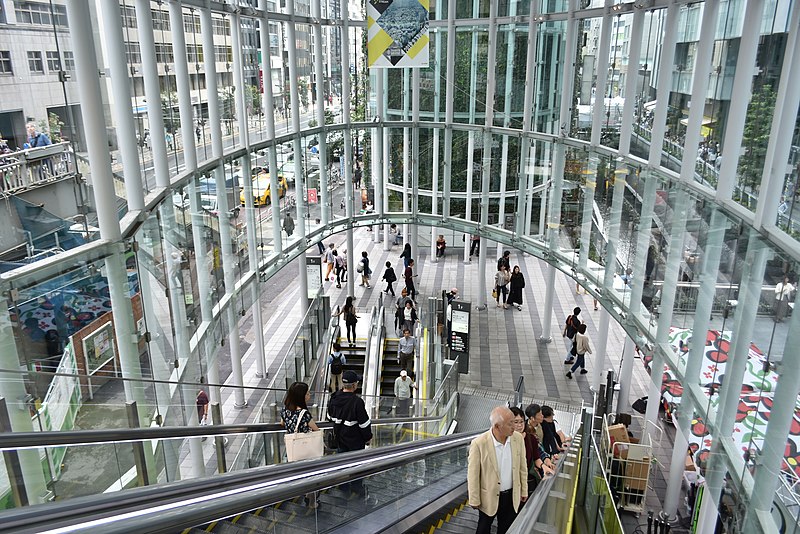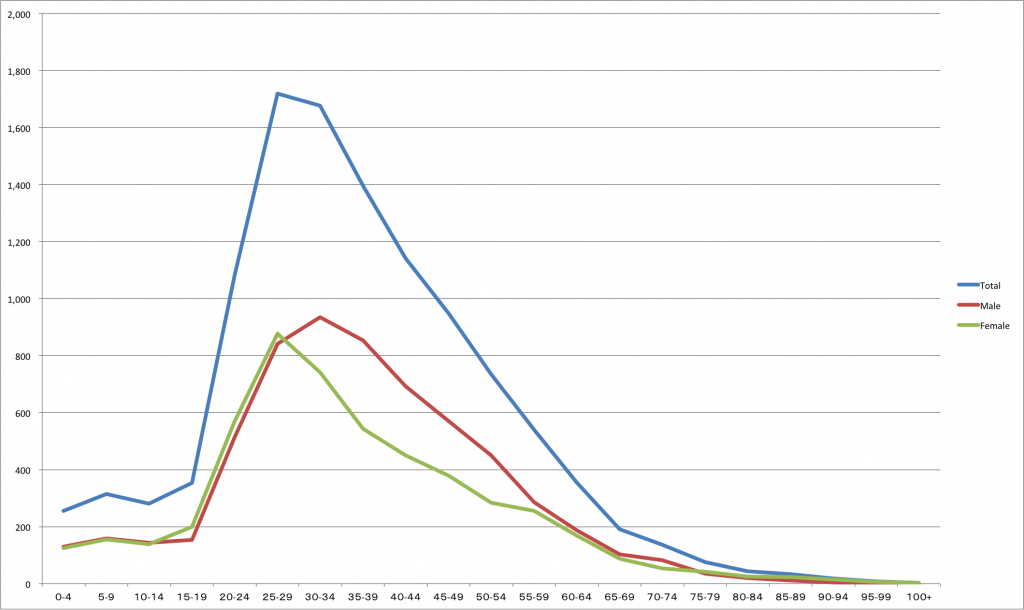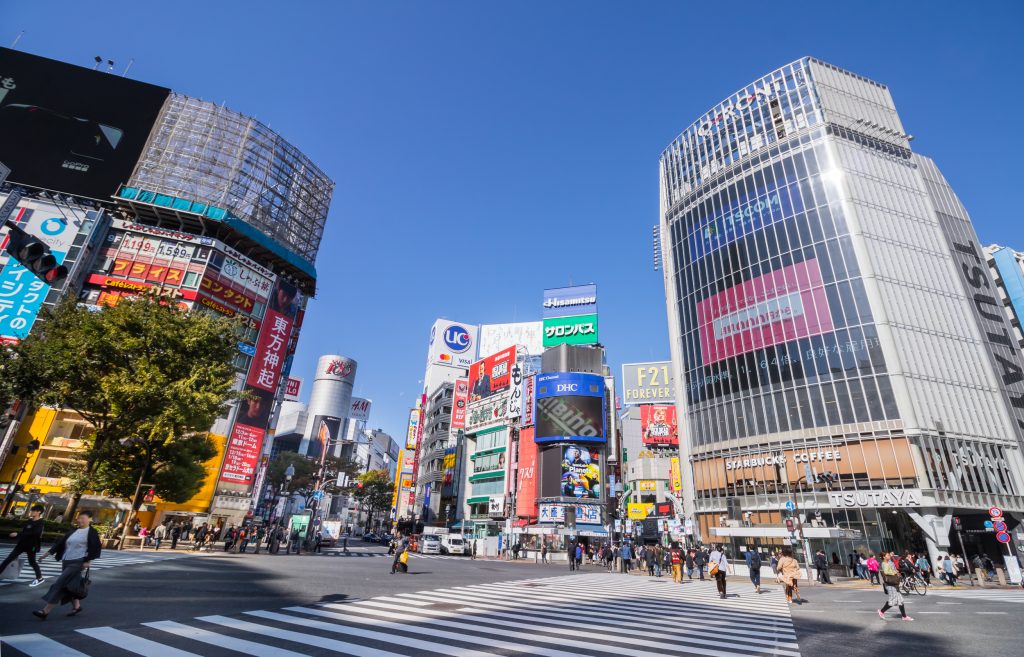What Google’s Return to Shibuya Signals for the Area
Shibuya is, ostensibly, a microcosm of Tokyo. A space in a constant state of flux. Protean and shape-shifting it gives itself a face lift on a daily basis. In the early noughties it was the center of Japanese youth culture, spearheading the ganguro (dark tan and heavy make up tribe which peaked in the 90s) and gyaru (a Japanese play on the English ‘gal’) movements which morphed into dolly-kei and fairy-kei enclaves years later.
Now, as a new decade appears on the horizon, and the Japanese population ages, it has begun to hark back to the olden days when Shibuya was a trading hub serving restaurants and wholesalers.
It’s hard to believe but Shibuya used to host a river – a vital artery which fed the people of central Tokyo with fresh fish and produce from the bayside. Developers have just gotten round to revitalizing this urban vein and the remnants of the river are being rejuvenated with new developments, retail projects and restaurants specializing in fish such as WIRED SHIBUYA a cavernous and industrial warehouse converted into a chic and contemporary seafood restaurant.
Shibuya Stream (the name – a cheeky and modern nod to the narrow waterway of old) is one of the latest developments to spring up near the station area. A gigantic 35-floor behemoth it’s one such project which is being viewed as a beacon of rejuvenation for the area. With hotel facilities, sports spaces, retail and restaurants being hosted in the building it’s a sign of things to come for the district. It’s the arrival of Google in November 2019, however, which sees Shibuya Stream and the future of Shibuya itself, as a geographical, commercial and financial game-changer.
Shibuya is rapidly emerging as a major tech area with an array of firms making it their home base. The district has been an emerging area for tech and startups for a while now, however, with the announcement of the Google arrival it marks a paradigm shift for the tech industry in Japan. It’s to be expected, naturally, that with the arrival of such a global tech giant that other such firms will follow suit so it’s odds on that Shibuya becomes the tech axis of Tokyo and therefore the whole of Japan.
In all likelihood the arrival of Google in Shibuya, an event which would be considered highly improbable a few years ago, will be considered an industry-wide rubicon in terms of tech’s future in Asia.

The position of Shibuya, in the core of Tokyo, with a myriad of train lines and hotels makes it an obvious choice for singles, couples and families. It has a long-standing reputation for being one of the most expensive cities in the world which, ultimately, is a fallacy. With an average lunch price of ¥1,148 (about $10 U.S.) and a fast food meal of ¥800 ($8 U.S.) it comes in, generally, under New York and other global centers. One of the major plus points of living in Tokyo is the price of public transportation. Sure, many expats use taxis and Uber (who are very much alive in Tokyo despite rumors) but most residents navigate the city by train. A 30-minute ride from Shinjuku to Asakusa (both well-known spots at opposing sides of Tokyo) costs roughly $3 U.S. and a shinkansen ticket from Tokyo to Kyoto (approximately 450km and just over two hours) will set back one person about $130 U.S. which makes Japan, essentially, one of the most cost-effective countries for public transport in the developed world.
For expats with families, Tokyo is perfectly balanced. It has a myriad of nightlife and social settings but it’s also very much family-friendly with a spectrum of parks (Yoyogi Park in Shibuya ward is a must-visit), kids clothing stores, restaurants which cater to children such as Royal Host (for affordable breakfasts and lunches) on Dogenzaka and a comprehensive Disney store in the Udagawacho area of the ward.
If you’re in the mood for a kids-focused Japanese cuisine option then stop by Uobei sushi restaurant just off Dogenzaka and Dubliners pub. It’s a fun-filled space for good quality sushi and a generally exciting Tokyo experience.

Moving along from Shibuya Stream, the nearby Hikarie complex (another mammoth retail and office space) is home to a spectrum of startups and IT companies interested in investing in a more inspired and international reputation. Shibuya is known as being one of the most cosmopolitan areas of the capital and the tech industry is boosting this in major ways.
More and more foreign-born workers are making Shibuya their base. And, in turn, restaurants, cafes, bars and stores are, by some kind of cultural osmosis, upping their game with services being offered in several languages. One such hangout (and popular for tech-industry players) is TRUNK (HOTEL). One of several spaces leading the new wave of boutique services it offers a small number of superb rooms, a hip bar with WiFi and benches for patrons to work on laptops, a few top-end eateries, a convenience store and event space.
This chart shows the number of foreign residents in Shibuya by age as of October 2019:

The total foreign population of Shibuya, Tokyo is 11,302 at time of writing and the ward has a total population of 229,728. A 5% foreign population in other major international cities may appear to be a low number but for Tokyo this is incredibly high and shows the areas cosmopolitan appeal.
Shibuya ward has the third largest population of North American residents in Tokyo and is well-known as a fashionable and sophisticated hub within the metropolis of Tokyo.

Known for its legendary crossing (at the Hachiko exit of the JR Shibuya Station) it’s an area which has a lot more to offer than just neon lights, tourist-focused pharmacies and chain stores. Many people are unaware that Shibuya ward actually includes areas such as Ebisu, Daikanyama, Harajuku, Hiroo, Yoyogi and Sendagaya. All of these areas have stunning examples of tranquility and peacefulness such as the Daikanyama T-Site complex, designed by leading architectural firm Klein Dytham in 2011, which has become a bastion of coolness and relaxation. Add to this the international mecca of Hiroo with its famous National Azabu international supermarket and international schools makes it an obvious choice for foreign residents looking for a cool and international vibe.
Now, it’s a subject which needs to be raised. With everything that Shibuya has to offer then how much are we talking about when it comes to rental accommodation? As of late last year (december 2018) the average price for a single room was ¥107,200, a one bedroom for a couple was ¥194,100 and a two bedroom family space coming in at ¥278,700. Compared with other global urban hubs such as London and New York, residing in Shibuya is an absolute steal. It has it all in terms of modern living requirements.
For single residents, Shibuya really is the best location in the city. 24-hour nightlife with cutting-edge clubs and live venues such as Womb, Contact, Liquidroom, Quattro, Shibuya O-East and O-West and WWW on your doorstep in addition to thousands of cafes, bars such as the superb Bridge bar which overlooks the Scramble crossing and restaurants ranging from the ultra cheap to the more luxurious. One recommendation is the legendary Kaikaya restaurant which is known as being one of the finest seafood eateries in the city.
Naturally a hub such as Shibuya plays host to more international bars such as Dubliners on Dogenzaka and an array of Hub pubs if you’re looking for a touch of home. For a more high-end experience with some incredible cocktails head to Fuglen in the elegant Tomigaya district of Shibuya. If you’re on the lookout for a taste of home, on the other hand, then look no further than Pie Face located in the Modi space minutes from Shibuya Station or the Hobgoblin British pub near Shibuya Mark City.
A few minutes from the station and near Tower Records is the recently opened Hotel koé – an upmarket and chic project which opened with a bang last year when it collaborated with New York-based brand Thom Browne. The adjacent and iconic Parco department store closed a few years back in order to reform, and transform into a newly built retail project due to open in November of this year.
One of Shibuya’s charms, however, is its role as a cultural hub. The legendary Bunkamura Museum is nestled within this bustling micro city and regularly plays host to blockbuster exhibitions such as Saul Leiter and The Burrell Collection. In Ebisu, photography lovers can revel in the TOP Museum (Tokyo Photographic Art Museum) which has recently been renovated and maintains its forward-thinking curation with shows by Nobuyoshi Araki, W. Eugene Smith and Matthew Barney. Nearby you’ll find NADiff bookstore tucked down a side street near the river. A stunning space with a small exhibition area in the basement which also has a small, curated retail operation selling brands such as Comme des Garcons. Add into the mix the beautiful Toguri Museum of Art which is a world leader of Japanese porcelain and you have yourself a triumvirate of leading museums within walking distance. The area also has a huge Tower Records which has a wonderful array of foreign magazines and books as well as a comprehensive CD selection and cafe/restaurant.
Shibuya is also a great spot for seeing public art. In Shibuya Station (Inokashira Line exit) visitors will find a large-scale mural by famed Japanese artistic visionary Taro Okamoto. The piece titled “Tomorrow Mythology” has been compared to Picasso’s “Guernica” and stands proud in one of the largest stations in the world. Renowned French graffiti artist Invader also has several works in the Shibuya area with the most well-known being the Astro Boy piece near Tower Records (under the train tracks). It’s a testament to the local government’s more open and progressive policies that street art is acceptable within the ward. Other areas aren’t so lucky as Japan, including Tokyo as a whole, doesn’t look favorably on graffiti and breaking laws and societal codes of conduct.
Apple, predictably, has a huge presence in Shibuya too with a mammoth Apple Store to satiate your tech vices while renowned Japanese stationery and retail store Tokyu Hands has a large branch located behind Parco. It’s a stationery geek’s paradise, yet it has, in recent times, expanded it’s enterprise to stock items such as bags, gadgets and electronics.
Shibuya is also perfect for cinema geeks with a huge Toho Cinema complex in addition to art house spaces such as Euro Space for a more intimate and avant-garde setting. For more bookish visitors, head to Kinokuniya Books, Tower Records, HMV Books (located within the Shibuya Modi structure) and the hipsterish Monocle magazine’s store in Tomigaya for a chance to pick up famed editor Tyler Brule’s latest masterpiece and indulge in some of the magazine’s retail collaborations with cutting-edge artisans. Add to this, the iconic Tsutaya store which looms over the famous Shibuya crossing next to the station – which is a nice spot for people watching and much-needed retail therapy.
Shibuya is a thriving and vibrant city with enough going on to fulfill any resident’s needs and requirements. Google’s arrival in November 2019 reaffirms the areas appeal and signals that the area will be growing in appeal for young techies as well as the wider community for years to come. Sometimes a walk through the back alleys can be as magical as the main thoroughfares. It’s a wonderful area in which to lose yourself and find your own, more customized, Shibuya. On a crisp autumn or spring day there’s nothing quite like a leisurely stroll from Shibuya to Harajuku. A 30-minute wander along Meiji-dori, Tokyo’s main artery, you feel the full-force of the expanse of Tokyo and the pulsating beats of the city, with Shibuya beautifully placed as its beating heart.
